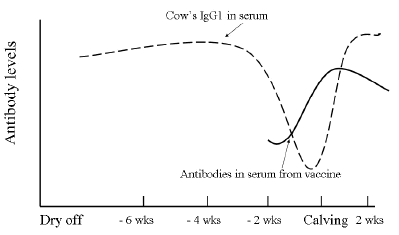



Vaccinating the Cow Protects the Calf
By Ron Erskine Dept. of Large Animal Clinical Sciences, Dairy Review, Michigan State University Extension. Colostrum is critical to protect the newborn calf, as it provides crucial antibodies to combat bacteria and viruses for the first several weeks, perhaps months, of life.Thus, it is essential that adequate (4 to 6 quarts in the first 6 hours) good quality (preferably tested with a colostrometer) colostrum, collected only from the first milking of cows, is a consistent part of a calf raising program. Antibodies generated by the cow from every day exposure to infectious agents are “passively transferred” via colostrum to the calf. Vaccination of cows to elevate immune protection from commonly transmitted diseases, such as Bovine Viral Diarrhea Virus (BVDV), Infectious Bovine Rhinotracheitis (IBR), Bovine Respiratory Syncytial Virus (BRSV), and Para-Influenza (PI-3), also can bolster the antibody “package” in the colostrum. Thus, a regular vaccination program is an insurance policy that can help protect two animals for the price of one, the cow and the calf. This is particularly important for protection of neonatal calves from common pathogens that cause diarrhea including Escherichia coli, and rota- and corona viruses. These calves less than 3 weeks of age, and at times contribute to high death rates. Vaccination of the calf to protect against these enteric pathogens generally is less useful because the calf’s immune system is not fully functional at this young age. Additionally, even if a calf’s immune system was able to respond to the vaccine and produce antibodies, the response to a first exposure is not very vigorous, and nearly 2 weeks would pass before maximum antibody concentrations would appear in serum.
Thus, the best way to impart protection to a calf against the neonatal diarrhea complex is to vaccinate the cow, which then transfers protection to the calf by way of colostrum.
To take advantage of this opportunity, the following guidelines should be considered.
- Don’t forget to vaccinate pregnant heifers, preferably twice before calving. The first shot at about 2 months before the due date for calving, and a booster 1 month before the due date.
- Accurate breeding dates, and thus expected calving dates are essential. Not all cows calve on schedule, and use of clean-up bulls extends the window of actual calving datesin relation to expected due dates. This can lead to problems with dry cow mastitis therapy, proper close-up ration feeding, and vaccination schedules. In the long run, the more accurate the calving dates, the better the vaccination results.
- Use proper vaccination handling and storage, dose, site of administration, and injection techniques.
- Consider vaccinating the cow at least 3 to 4 weeks before Calfcalving. The reason for this is illustrated in Figures 1 and 2. Typically, cows start to generate antibodies, particularly IgG1 the most common form of antibody in cattle, a week or more before calving. As calving nears, there is a precipitous drop of IgG1 in the serum of the cow as the colostrum is more intensively packaged (Figure 1).
Figure 1. Antibody levels in response to vaccination 2 weeks before calving.

If a cow were vaccinated in the last 2 weeks before calving, assuming she calves on the due date, she would not have peak quantities of antibodies from the vaccine in colostrum until very nearly the calving date, and thus would probably not offer optimum antibody transfer to the calf. However, if the vaccination is administered earlier in the dry period, at least 3 to 4 weeks before calving, or even at dry off, the cow will respond to the vaccine with her antibody response well before the time IgG1 is deposited into colostrum (Figure 2).
Figure 2. Antibody levels with vaccination 4 weeks before calving
.
The important concept is that if you wait to vaccinate the cow too close to calving, or if she calves before her due date, it is possible that the vaccines’ contribution to colostrum will be less effective.
- Most important----if a sound colostrum program is not in place, vaccination will likely fail, no matter how good the vaccination schedule and technique.
- Vaccines are not magic bullets that can overcome poor management practices such as calves maintained on damp bedding, in poorly ventilated housing, exposed to poor biosecurity, or fed inadequate nutrition (for example, not enough milk replacer during cold weather).
- Vaccines don’t exist, or may be less effective, for other pathogens such as Cryptosporidia and Salmonella. If the previous guidelines are being followed, and a diarrhea problem still exists in your neonatal calves, consultation with a veterinarian and potential use of a diagnostic laboratory may be needed to insure proper diagnosis of the causative agent(s)



